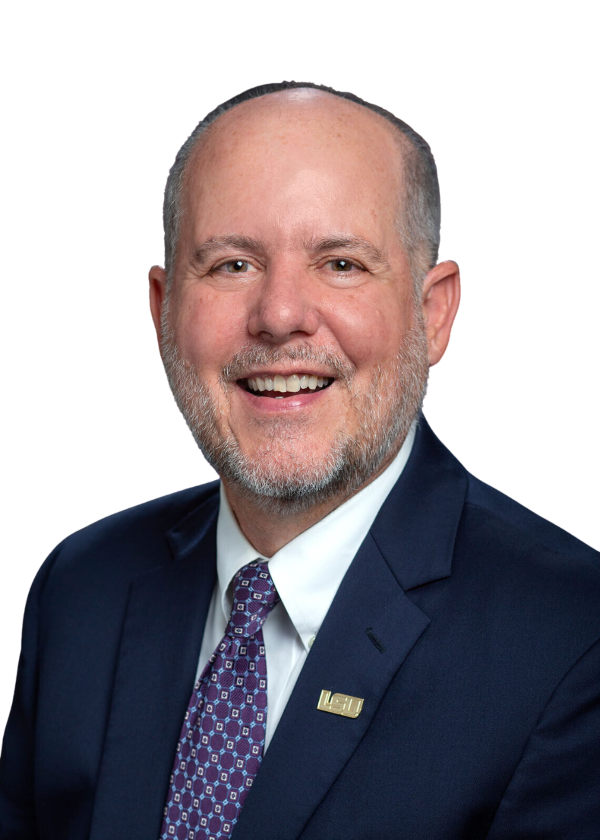Leading the Way from Classroom to Coastline
INSIGHT INTO INTERIM DEAN CLINT WILLSON'S RESEARCH AND HOW THE LSU COLLEGE OF THE COAST & ENVIRONMENT WILL ADVANCE THE SCHOLARSHIP FIRST AGENDA

A Discussion with Clint Willson
Please briefly describe your research. How did you decide to focus on this particular area? How is it important to you?
My research interest is in the broad area of environmental fluid mechanics. I spent the first several years at LSU using high-resolution three-dimensional x-ray computer tomography (XCT) to improve our understanding of fundamental flow and transport processes in porous media, with applications to groundwater flow, fate-and-transport of pollutants, and oil-and-gas production. This work was influenced and shaped by some incredible collaborators from across the LSU campus, including Les Butler (Chemistry), Rich Kurtz (Physics), and Karsten Thompson (then Chemical Engineering).
In 2002, I was asked by my department chair and dean to lead LSU’s effort to develop an on-campus physical modeling program aimed at improving our understanding of the Mississippi River hydraulics and sediment transport. While a significant departure from my other research program, a lot of hard work by LSU alumni, faculty, staff and students, along with support from the Louisiana Department of Natural Resources coastal engineering group (now part of the Coastal Protection and Restoration Authority (CPRA)) enabled us to construct the Vincent A. Forte Coastal & Hydraulics Lab, just behind the LSU Vet School. That facility and our work to provide relevant, defendable data to the state demonstrated the importance need of having a world-class facility to conduct research and educate students, stakeholders and policy makers. In 2018, the LSU Center for River Studies (CRS), a ~45,000 sq ft facility, was opened on the Baton Rouge Water Campus, where it sits directly next to the CPRA, our long-time collaborator and partner. The Center hosts approximately 8000 visitors a year, as well as dozens of workshops and events. What I love about the Center is our ability to educate people about our coast and the river, while simultaneously letting them see LSU research in “real time”.
What impacts have you seen from your research? How have these impacts shaped your career?
I would say there are three major impacts. First, data and results from our research are being directly used by the Coastal Protection and Restoration Authority, along with numerical modeling and field work, to develop and adapt plans for how they will optimize river sediment diversion operations. It is very rewarding to produce actionable data that is so vital to our coastal restoration efforts.
The second impact is directly related to my involvement with the Ogden Honors College. Through guest lectures, teaching classes and interaction with some amazing students, I have learned so much about the history of the river and our coast and how those shaped our economy, culture, communities and politics. This directly translates into how we educate and inform people about how so much of our coast was formed by the river and how we are now attempting to better manage the river for navigation, flood control and restoration. Helping people understand how we ended up with the current system and associated problems, makes it much easier to talk about what the CPRA is now trying to do.
Finally, we have been able to have over 100 undergraduate and graduate students work on the river models. Not only do they get to conduct experiments and collect data, but they also write reports and make presentations to CPRA and other stakeholder groups. The students also learn how to better communicate with a wide range of people – from middle school students to river scientists and engineers to state and federal elected officials and policy makers. These experiences, plus their solid LSU education, makes them extremely competitive for jobs and graduate programs.
How does your research relate to LSU’s Scholarship First Agenda? How can coastal and environmental research, and the LSU College of the Coast & Environment in particular, impact and serve Louisiana?
The Mississippi River has played, and continues to play, a major role in shaping our state’s coast, culture, communities, and economy. The river sediment diversions are the state’s attempt to allow, in a managed way, the river to do what is used to do – feed, nourish and sustain some of our coastal wetlands that perform so many important ecosystem services. However, those efforts must not impact navigation and our ability to get agricultural, petrochemical and other critical goods and products into and out of the Gulf of Mexico. And, while restoring our wetlands and maintaining navigation, we must continue to reduce the risk to our communities and citizens from flooding and natural disasters. The LSU College of the Coast & Environment, along with researchers from across campus and the system, are critical to making the discoveries, developing the solutions, and educating our students to ensure a robust, resilient and productive future for the state of Louisiana.